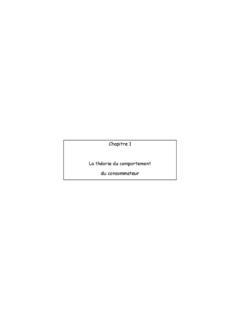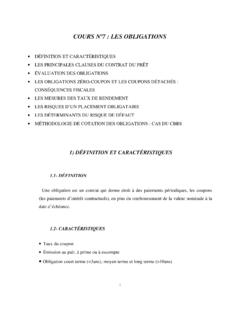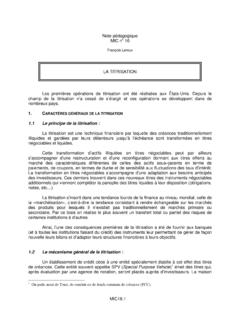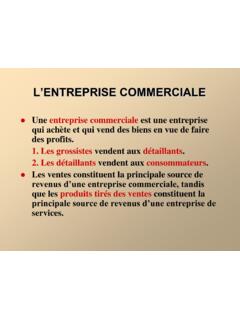Transcription of Stochastic Di⁄erential Equations Exercises - HEC Montréal
1 Stochastic Di erential EquationsExercisesExercise Stochastic process Ct=C0e Wt:t 0 ; r0 0represents the exchange rate evolution, that isCtis the timetvalue in the domestic currencyof one unit of the foreign currencyfWt:t 0gis a standard Brownian )What is the Stochastic di erential equation satis ed byfCt:t )The price evolution of a risky asset, expressed in the foreign currency, is denotedfXt:t 0g. It satis es the SDEdXt= Xtdt+ XtdW twherefW t:t 0gis a Brownian motion, independent offWt:t 0g:What is the SDE ofthe risky asset pricefYt:t 0g, expressed in the domestic currency? exercise )Show that there is a unique solution todXt=a(b Xt)dt+ dW(t):b)Find explicitly this )What behavior do you expect if the parameters are.
2 A= 1; b= 1; = 1; t= 0;01andX0= 1a= 1; b= 1; = 1; t= 0;01andX0= 1a= 1; b= 1; = 0;1; t= 0;01andX0= 1a= 1; b= 2; = 0;3; t= 0;01andX0= 1 exercise the behavior of the solution ofdXt= 12 Xt dt+pXt(1 Xt)dWtassuming thatX0is a random variable taken value in the unit interval[0;1]. Explainintuitively whyXttakes value Assume that a particle move randomly in a plan such that its position attimetis given by W(1)t;W(2)t whereW(1)andW(2)are independent Brownian distance to the origin isBt=r W(1)t 2+ W(2)t 2; t >0:Knowing that the quadratic covariation of two independent martingale is nil, use It s lemmato show thatdBt=121 Btdt+W(1)tBtdW(1)t+W(2)tBtdW(2)t:Exercis e that the Stochastic processfSt:t 0gwhereSt=S0exp Zt0 sds 22t+ Wt andWis a( ;F;fFt:t 0g; P) Brownian motion satis esdSt= tStdt+ StdWt: exercise Vasicek that the Stochastic processfrt:t 0gwherert= +e t r0 + e tZt0e sdWsandWis a( ;F;fFt:t 0g.)
3 P) Brownian motion satis esdrt= ( rt)dt+ dWt:Hint : LetYt=Rt0e sdWsand show thatYis an It the system of Stochastic di erential Equations :dXt= ( Xt)dt+ dWtdYt=e e Yt dt+e dfWtwhere theP Brownian motionWandfWare such thatCorrPhWt;fWti= ,8t > )Find the unique strong solution of this )DetermineEP[Xt]:c)The parameter is called thelong term meanand the parameter is thespeedof reversion. Justify these )DetermineVarP[Xt]:e)DetermineCorrP[Xt; Yt]:3 Solutions1 exercise ) Letf(w) =C0e w. Sinceddwf(w) =C0 e wandd2dw2f(w) =C0 2e w;f(Wt) =Ct,dfdw(Wt) = Ctandd2fdw2(Wt) = 2Ct:Using It s lemma, we getdCt= CtdWt+ 22 Ctdt:b) The multiplication rule leads todYt=dXtCt=XtdCt+CtdXt+dhX; Cit=Xt CtdWt+ 22 Ctdt +Ct( Xtdt+ XtdW t)= YtdWt+ 22 Ytdt+ Ytdt+ YtdW t= YtdWt+ YtdW t+ 22+ Ytdt:2 exercise ) We need to verify that.
4 (i)jb(x; t) b(y; t)j+j (x; t) (y; t)j Kjx yj;8t 0(ii)jb(x; t)j+j (x; t)j K(1 +jxj);8t 0(iii)E[X20]<1 Veri cation of(i) :jb(x; t) b(y; t)j+j (x; t) (y; t)j=ja(b x) a(b y)j+j j=jajjx yj:4 Veri cation of(ii) :jb(x; t)j+j (x; t)j=ja(b x)j+ jabj+jajjxj+ max (jabj+ ;jaj) (1 +jxj)LetK= max (jabj+ ;jaj).Veri cation of(iii) :because the initial condition is not speci ed, we need to chose a squareintegrable random )LetZt=Xt b:It s lemma implies thatdZt=dXt=a(b Xt)dt+ dW(t)= Zt+ dW(t):The Stochastic processZis an Ornstein-Uhlenbeck process and we have shown that thestrong solution isZt=Z0e at+ e atZt0easdWs:ReplacingZtwithXt b;we getXt b= (X0 b)e at+ e atZt0easdWs:That is why the solution IsXt=X0exp ( at) +b(1 exp ( at)) + exp ( at)Zt0exp (as)dWs:LetYt=Rt0exp (as) :t2[0; T]gis an It process1withY0= 0,Ks= 0andHs=eas.
5 Moreover,Xt=X0exp ( at) +b(1 exp ( at)) + exp ( at)Yt:1 Rappel. Le processus stochastiqueX=fXt: 0 t Tgest un processus d It si pour toutt2[0;T];XtP +Zt0 Ksds+Zt0 HsdWso X0est une variable al atoireF0 mesurable, les processusK=fKt: 0 t TgetH=fHt: 0 t TgsontF adapt s,ZT0jKsjds<1etZT0H2sds<1P le cas qui nous occupe,RT0jKsjds=RT00s= 0etRT0e2asds=12e2Ta 1a<1:5 Letf(y; t) =X0e at+b(1 exp ( at)) + e atyand note that@f@Y(y; t) = e at@2f@Y2(y; t) = 0ddt X0e at+b(1 exp ( at)) + e aty =a X0e at+be at e aty =a b X0e at b+be at e aty =a(b f(y; t)):SinceXt=f(Yt; t), the fourth version of It s lemma2gives the desired result:df(Yt; t) =@f@Y(Yt; t)HtdWt+ @f@Y(Yt; t)Kt+@f@t(Yt; t) +12@2f@Y2(Yt; t)H2t dt:dXt=df(Xt; t)= e ateatdWt+ e at0 +a(b f(Yt; t)) +120 (eas)2 dt= dWt+a(b f(Yt.))
6 T))dt= dWt+a(b Xt)dt: 3 exercise drift term12 Xtinduce a reversion behavior toward12. Indeed, ifXt>12, then12 Xt<0;implying that the local behavior ofXtends to decrease just aftert:On theother hand, ifXt<12, then12 Xt>0, implying thatXtends to increase. IfXt=12, thenthe drift term is nil, having locally no impact di usion termpXt(1 Xt)reaches a maximum atXt=12. It worth zero wheneverXt= 0or1. IfXt= 0, the drift term is positive and the di usion term is nil, implying that2 Rappel :df(Yt;t) =@f@Y(Yt;t)HtdWt+ @f@Y(Yt;t)Kt+@f@t(Yt;t) +12@2f@Y2(Yt;t)H2t dt:6Xt+"is strictly positive. IfXt= 1, then the drift term is negative and the di usion term isnil, implying thatXt+"<1:4 exercise (w1; w2) =pw21+w22:@f@w1(w1; w2) =w1pw21+w22=w1f(w1; w2);@f@w2(w1; w2) =w2pw21+w22=w2f(w1; w2);@2f@w21(w1; w2) =w22 pw21+w22 3=w22(f(w1; w2))3;@2f@w22(w1; w2) =w21 pw21+w22 3=w21(f(w1; w2))3;and@2f@w1@w2(w1; w2) = w1w2 pw21+w22 3:7 Therefore,dBt=df W(1)t; W(2)t =W(1)tf W(1)t; W(2)t dW(1)t+W(2)tf W(1)t; W(2)t dW(2)t+12 W(2)t 2 f W(1)t; W(2)t 3d W(1) t+12 W(1)t 2 f W(1)t; W(2)t 3d W(2) t W(1)tW(2)t f W(1)t; W(2)t 3dDW(1);W(2)tEt=W(1)tf W(1)t; W(2)t dW(1)t+W(2)tf W(1)t; W(2)t dW(2)t+12 W(1)t 2+ W(2)t 2 f W(1)t.
7 W(2)t 3dt=W(1)tBtdW(1)t+W(2)tBtdW(2)t+12B2tB3t dt=W(1)tBtdW(1)t+W(2)tBtdW(2)t+121 Btdt:85 exercise )Xt= + (x0 ) exp ( t) +Zt0 exp ( (t s))dWsYt=e + x0 e exp ( e t) +Zt0e exp ( e (t s))dfWsb)EP[Xt] = EP + (x0 ) exp ( t) +Zt0 exp ( (t s))dWs = + (X0 ) exp ( t) + EP Zt0 exp ( (t s))dWs |{z}=0= + (x0 ) exp ( t):c) If 0;limt!1EP[Xt] = limt!1 + (x0 ) exp ( t) = ;that is,8" >0,9t( ; ")>0such that8t > t( ; "), EP[Xt] < ".Note that if0 1< 2, thent( 1; ")> t( 2; "), that is, the larger is, more quicklyEP[Xt]revert back to .d)VarP + (x0 ) exp ( t) +Zt0 exp ( (t s))dWs = VarP Zt0 exp ( (t s))dWs = EP" Zt0 exp ( (t s))dWs 2#= EP Zt0( exp ( (t s)))2ds =Zt0( exp ( (t s)))2ds= 22 1 e 2 t :9e)CovP[Xt; Yt] = CovP" + (x0 ) exp ( t) +Rt0 exp ( (t s))dWs;e + x0 e exp ( e t) +Rt0e exp ( e (t s))dfWs#= CovP Zt0 exp ( (t s))dWs;Zt0e exp ( e (t s))dfWs = EP Zt0 exp ( (t s))dWs Zt0e exp ( e (t s))dfWs = EP Zt0 exp ( (t s))e exp ( e (t s)) ds = e Zt0exp ( ( +e ) (t s))ds= e +e 1 e ( +e )t :CorrP[Xt; Yt] =CovP[Xt; Yt]qVarP[Xt]qVarP[Yt]= e +e 1 e ( +e )t q 22 (1 e 2 t)qe 22e (1 e 2e t)= 2 p e +e 1 e ( +e )tp(1 e 2 t) (1 e 2e t):10
















